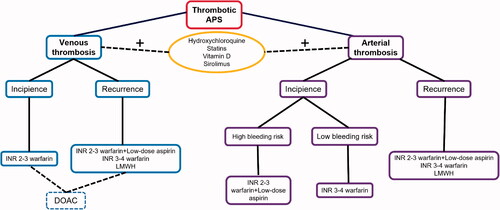Figures & data
Table 1. Pathophysiological mechanisms mediated by aPL.
Table 2. Summary of digestive system manifestations associated with APS.
![Figure 1. Thrombotic mechanisms mediated by aPL. Thrombus formation can be promoted in the different ways [Citation1]: aPL interacts with endothelial cells [Citation2]; aPL activates mononuclear cells, induces expression of tissue factors, proteinase activated receptors and proinflammatory cytokines [Citation3]; aPL interacts with platelets [Citation4]; aPL inhibit fibrinolysis.aPL:antiphospholipid antibodies; β2-GPI:β2-glycoprotein I.](/cms/asset/4c06b056-df1b-4749-90b8-6ccc5b058e63/iann_a_1962964_f0001_c.jpg)

